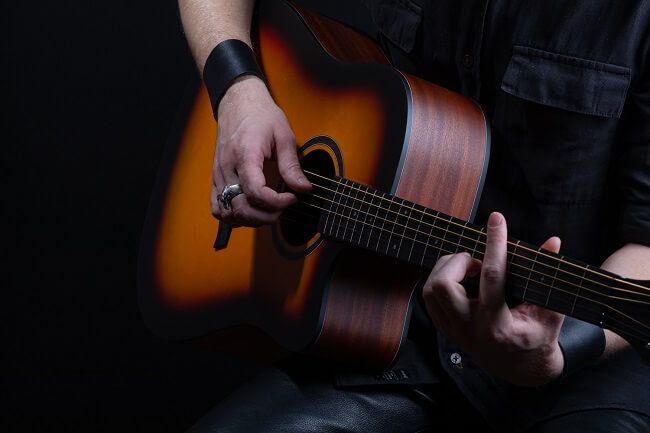Playing with fingers
Playing the guitar with fingers is one of the fundamental methods, which has its unique advantages and characteristics. Here are a few reasons why many guitarists prefer playing with fingers:
1. Expressiveness and articulation: Playing with fingers provides greater control over dynamics and tonal quality. Fingers can directly influence the strings, creating various nuances and expressiveness in music.
2. Acoustic guitar and fingerstyle: On an acoustic guitar, fingerstyle playing allows for creating a rich and melodic sound. Guitarists use different fingers for independent string plucking, enabling them to play intricate melodies and bass lines simultaneously. 
3. Classical music: In classical music, fingerstyle playing is a traditional method. Guitarists use nails and fingers to perform complex compositions, producing a clear and clean sound.
4. Sweetness and warmth of tone: Playing with fingers contributes to a softer and warmer tone. This method emphasizes muted and articulated sounds, which is particularly valued in styles like folk, blues, and jazz.
5. Tremolo and slides technique: When playing with fingers, guitarists can easily incorporate techniques like tapping and slides, adding variety and virtuosity to their performance.
6. Versatility: Guitarists playing with fingers can easily switch between different styles, incorporating fingerstyle elements into more traditional methods.
The history of the guitar pick
The history of the pick’s appearance on the guitar dates back to the mid-20th century, and while exact details are not always clear, there are several versions of how the pick became such an important tool for guitarists.
One version is associated with a group of musicians in New York in the 1920s who, according to legend, used shards of car windows as picks. These shards provided guitarists with a new sound and variability in playing.
The wider adoption of picks occurred during the development of electric guitars. With the emergence of electric guitars in the 1930s and 1940s, guitarists faced new challenges, such as the need to create a brighter and more articulate sound.
One of the earliest mentions of a pick in print was in 1922 in the “Music Trades” magazine. The article claimed that some guitarists were starting to use wooden or folded paper pieces as picks.
Over time, picks began to be made from various materials such as tortoiseshell, nylon, wood, metal, and other synthetic and natural materials. Each material gave the pick unique sonic characteristics, allowing guitarists to tailor their sound to their preferences.
Thus, the pick became an integral part of the guitar world, providing players with greater articulation, dynamic control, and the ability to create various sound effects.
When to use a pick
1. Electric guitar:
Rock, Metal, and Punk: Picks are widely used in electric music styles such as rock, metal, and punk. They create brighter and more aggressive sounds suitable for fast riffs and solos.

2. Accompaniment and rhythm:
Accompaniment and rhythm playing: Picks provide more accurate and even reproduction of rhythmic patterns, making them an excellent choice for accompaniment.
3. Speed techniques:
Fast and complex passages: When playing fast and intricate melodies, especially on an electric guitar, a pick provides the necessary precision and striking force.
When to combine both methods
In some cases, guitarists combine fingerstyle and pick playing within a single composition. This allows achieving richness of sound and diversity of techniques, especially when playing solos and complex arrangements.

Ultimately, the choice between playing with fingers and using a pick is a matter of style, preferences, and the requirements of a specific composition. Experiment with both methods, find your unique style, and enjoy the process of musical creativity!